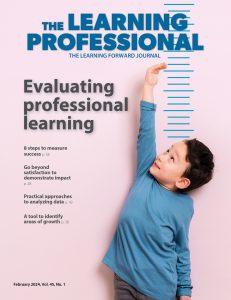In the unprecedented crisis we’re all facing, educators need culturally responsive competencies more than ever. In situations of urgency, it’s human nature to default to old patterns and drop hard-won awareness practices. We can keep that from happening, and through this crisis become even more effective as culturally responsive practitioners.
Who we are as individuals and as members of racial, class, gender, age, and other social groups influences how we experience and act in the face of the current crisis. Applying a culturally responsive lens helps us focus on how to respond compassionately, respectfully, and effectively to one another across differences.
It may seem contradictory, but the first step in culturally responsive practice is creating emotional stability in ourselves. When we support others from a base of unexamined fear or grief, it’s difficult to meet people where they are, let alone connect across different lived experiences of age, race, class, gender, or cultural groups of any kind. When we establish our own stability first, we have more emotional energy for others, as well as a clearer sense of our own social perspective.
''It may seem contradictory, but the first step in culturally responsive practice is creating emotional stability in ourselves.'' Click To TweetThe next essential step is listening. Especially while we are physically separated from one another, listening builds relational trust, broadens our understanding of the challenges, and allows expert voices from diverse communities to emerge, giving us a much stronger base for problem-solving.
Starting with self-care
Right now, coaches, school leaders, and teachers are expected to be leading others, while at the same time many of us are anxious, afraid, or grieving ourselves. We’re expected to take charge, have answers and solutions, and be there for more vulnerable people, while we may be struggling to care for our own families and friends. We’re leading a mass experiment, teaching students online with no advance notice and little preparation.
Fears can be rational, but they shouldn’t drive us. While the phrase “putting on our own oxygen masks first,” is overused, we need to practice this life-saving action even at the same time as we respond to the urgent needs to make sure students are safe and fed and to launch online teaching. Neuroscience tells us that when stressed, we’re in a state of “amygdala hijack,” physically pumping the stress hormone, cortisol, into our veins. We can take steps to reduce cortisol. The trick is to observe emotions, name them and allow them to move through us, rather than letting them drive our actions.
If I don’t know I’m anxious, I may believe that the solution to the disquiet inside of me is to work harder or tell the people around me what to do with more force and emphasis. But if I can notice my fears and needs, I have many more choices on how to proceed. Cultivating calm instead of anxiety leads to resilience, improved thinking capacity, and increased immunity. The simplest term for noticing and naming emotions is mindfulness.
Here’s an example of how mindfulness can help. My own fears in the last few weeks have taken very physical forms – knots in the stomach and headaches. To help manage them, I have a stretching and meditation practice every morning, before I begin my work or look at the news. When I can, I take walks in nature and look for signs of spring. I talk to friends and we listen to each other. All of this helped me support my teenage daughter, who was painfully disappointed about the many losses she is experiencing due to the shelter-in-place order. Because I took time to first talk about all my own disappointments with another adult, I was able to be more clear and focused to hear hers. The same principle applies to providing similar support to a whole class of students or school of colleagues – at that scale, we need mindfulness and self-care strategies even more.
Moving from self-care to cultural responsiveness
This awareness of ourselves and our current states sets the stage for us to be aware of and responsive to others’ perspectives and needs. It is more important than ever that we do this work with a culturally responsive lens. Those of us from a dominant culture always need to remember to monitor our assumptions and beliefs about the capabilities and choices of both students and colleagues from multiple cultures and social identity groups. All of us will need to put extra thought and attention into noticing our perspective and judgments, now that we have little-to-no in-person contact with anyone outside of our family pod.
''All of us will need to put extra thought and attention into noticing our perspective and judgments, now that we have little-to-no in-person contact with anyone outside of our family pod.'' Click To TweetNot only our students but our adult colleagues may lack equal access to resources or technology. Struggles with social distancing may look different across cultural, linguistic, class, or race lines. And anxieties are shaped by both our personal experiences as well as those of our communities.
To help broaden our understanding of what others are experiencing, we can and should continue asking ourselves questions like these: How does my own social identity help or limit my being able to support the people I work with? What assumptions am I making about families’ or colleagues’ lives and needs right now? What might I be missing? As a white person, how am I listening to and learning from people of color now? As a man, how am I listening to women? How am I balancing the giving of information with attention to social and emotional needs?
As we are all still adjusting to the new rules, agreements, and systems, we can start with listening. Many of us in leadership roles are now giving directives, and we all (whether leaders or not) are often compelled to tell others what they should or should not be doing. Yet, even in times of crisis, people from a dominant culture telling people from a non-dominant culture what to do is hard to separate from histories of oppression and injustice. Our social identity in combination with our role identity, plus our tone, impacts how we are heard.
I was recently in an online meeting where the program administrator, a white, middle-class man leading a group of multi-racial participants made an effort to set firm boundaries about social distancing and not mixing “germ pods.” He publicly commented towards one of the participants, “You delivered the Chromebook to the student’s house? You definitely should not be doing that!” While the leader had valid information to convey, he skipped the vital first step of empathic listening to the intention behind the teacher’s actions. Equally significant, he did not self-monitor his tone, which was heard by many as shaming and patronizing, and was triggering for people of color and women who often experience white men in positions of power asserting that their way is the “right way.” When I asked a few people later what they took away from the meeting, one said, “I didn’t need someone else to tell me I’m bad at a time like this.” Another said, “He doesn’t understand or care about our situation.” At least one had resolved “not to let him know what I’m doing next time.”
When we are aware and notice ourselves judging others (for example, thinking “This teacher/colleague/family/child is doing something wrong”), we have an opportunity to return to culturally responsive practice. We can ask ourselves again what we might be missing, even with adults we think we know well. Then we can ask others what we’re missing and what their needs are. In our urgency to address many demands, it may feel like there is no time to listen now. But there is.
''When we are aware and notice ourselves judging others, we have an opportunity to return to culturally responsive practice.'' Click To TweetEssential practices in times of crisis
I hear many people struggling to figure out the most important priorities in working with teachers and colleagues now. The practices suggested below are derived from my experience as a coach, consultant, and leader. They apply to coaching and other professional relationships. Their sequence is important.
In the spirit of cultural responsiveness, I acknowledge that there is no one right approach for everyone, and my approach as a white, middle-class woman will not fit every situation. But I hope the tips offer inspiration and build on what you already know from past practice.
- First, acknowledge your own fears and anxieties, tend to them, and put them aside before entering into a coaching or leadership situation
- Listen to those you are aiming to support.
- Keep listening, perhaps for an agreed-upon amount of time, without interrupting, or jumping in to fix anything.
- Paraphrase and verbalize what you heard to the other person, to make sure you really understand the person’s individual situation and needs.
- Ask yourself, what might I be missing?
- Express empathy for the person’s specific situation and feelings.
- Help guide the person towards identifying what he or she can and can’t control, and what he or she most needs.
- Assure the person you are coaching/leading that he or she is not alone, and share what you can and cannot do to support him or her, asserting healthy boundaries.
- Identify a key area within the person’s locus of control, and help him or her identify specific goals to accomplish with specific timelines (e.g. – “My teaching goal between now and Friday is to set up student rules and protocols for using the Zoom platform,” or “My self-care goal is to stop, step outside, and breathe for ten minutes, three times a day.”)
- Help them to identify all relevant public health expectations and educational system changes, and to solve any challenges in meeting those expectations.
In following these practices and this sequence, we are not only building relational trust, but we are modeling for teachers and leaders how to take the same approach with their students. Ultimately, we want teachers to ask themselves the same questions about their students that we are asking about them: What is working for my students? What do I know about their situations, and what might I be missing? How does my social identity support or limit my understanding of what others are going through? What support do I need in order to provide quality education to all under these extreme circumstances? What would need to change in the system for me to get that support?
Coaching and leading for equity during the crisis
The months we will spend in this crisis will profoundly exacerbate existing inequities and academic gaps between privileged and non-privileged students. We must stay alert to academic practices that may widen the gap even more. At the same time, just as we are learning that there are benefits to our global environment and air quality from the COVID-19 crisis, we should be alert to the possibility that the crisis will reveal some educational solutions that promote more access and academic success for all students. Being aware of ourselves, others, and the vitality within our different points of view is key to developing practices that will provide the full range of students with an engaging, rigorous, and responsive education.
Many of us, without realizing it, have been preparing for this crisis all along. Here is an opportunity as school leaders, coaches, and teachers to pull out everything we’ve learned about coaching practice, effective communication, resilience, self-care, and cultural responsiveness, and apply it. The crisis is affirming for us that we are all connected. It is a time like no other, and we can hope to come out of it having strengthened our skills, our vision, and even better prepared for the long road ahead.
 Sarah Young (sarah@sarahyoungconsulting.com) works as a consultant supporting teacher effectiveness for educational equity. As a coach and workshop facilitator, she has a special focus on culturally responsive practice, coaching and communication skills, and adult social and emotional learning.
Sarah Young (sarah@sarahyoungconsulting.com) works as a consultant supporting teacher effectiveness for educational equity. As a coach and workshop facilitator, she has a special focus on culturally responsive practice, coaching and communication skills, and adult social and emotional learning.
COVID-19 Statement | Resources | Support Community
Additional resources
- https://www.tolerance.org/magazine/online-teaching-can-be-culturally-responsive
- https://hbr.org/2020/03/that-discomfort-youre-feeling-is-grief?fbclid=IwAR3ZPgqeCF9u-2kfzOVuBbxwPcI-F91EME1tMeb6dCQD2AVi_a8hVKntAwc
- https://learningforward.org/2019/12/culturally-responsive-coaching-is-more-than-just-good-coaching/
- https://childmind.org/article/self-care-in-the-time-of-coronavirus/








